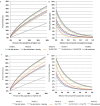Combined associations of genetic and environmental risk factors: implications for prevention of breast cancer
- PMID: 25392194
- PMCID: PMC4271030
- DOI: 10.1093/jnci/dju305
Combined associations of genetic and environmental risk factors: implications for prevention of breast cancer
Abstract
Genome-wide association studies (GWAS) have identified hundreds of genetic susceptibility loci for cancers and other complex diseases. However, the public health and clinical relevance of these discoveries is unclear. Evaluating the combined associations of genetic and environmental risk factors, particularly those that can be modified, will be critical in assessing the utility of genetic information for risk stratified prevention. In this commentary, using breast cancer as a model, we show that genetic information in combination with other risk factors can provide levels of risk stratification that could be useful for individual decision-making or population-based prevention programs. Our projections are theoretical and rely on a number of assumptions, including multiplicative models for the combined associations of the different risk factors, which need confirmation. Thus, analyses of epidemiological studies with high-quality risk factor information, as well as prevention trials, are needed to empirically assess the impact of genetics in risk stratified prevention.
Published by Oxford University Press 2014.
Figures

Comment in
-
Re: Combined associations of genetic and environmental risk factors: implications for prevention of breast cancer.J Natl Cancer Inst. 2015 May 7;107(6):djv127. doi: 10.1093/jnci/djv127. Print 2015 Jun. J Natl Cancer Inst. 2015. PMID: 25957379 Free PMC article. No abstract available.
References
Publication types
MeSH terms
Substances
Grants and funding
LinkOut - more resources
Full Text Sources
Other Literature Sources
Medical

